When it comes to animals that live in America, there is no shortage of different species. America is blessed with a wide range of genetic diversity, which has led scientists to identify over 32,000 different animal species within our borders. That’s a lot of wildlife!
While I can’t include all 30,000+ animals within U.S. borders on the list, I’m sharing a list of over 100 animals that call this country home. After the list, you’ll find more information about some of the most iconic animals in that live in America, like bison, alligators, wolves, coyotes, bald eagles, and more.
100+ Animals That Live In America
Below is a list of over 100 animals that live in America.
- Bald Eagle
- American Bison
- White-tailed Deer
- American Alligator
- Eastern Gray Squirrel
- Red Fox
- Mountain Lion
- Wild Turkey
- Black Bear
- Raccoon
- Opossum
- Prairie Dog
- Bottlenose Dolphin
- Blue Jay
- Northern Cardinal
- American Robin
- Brown Pelican
- Sea Otter
- Western Diamondback Rattlesnake
- Timber Rattlesnake
- Copperhead Snake
- American Bullfrog
- Monarch Butterfly
- Western Tiger Swallowtail
- American Painted Lady Butterfly
- Eastern Bluebird
- American Goldfinch
- Red-tailed Hawk
- Bobcat
- North American River Otter
- American Black Duck
- Mallard Duck
- American White Pelican
- American Pika
- American Mink
- Pronghorn
- Gray Wolf
- American Crow
- Northern Mockingbird
- American Badger
- Virginia Opossum
- Eastern Chipmunk
- American Red Squirrel
- American Toad
- Eastern Box Turtle
- White Pelican
- Black Rat Snake
- Eastern Garter Snake
- Florida Panther
- Gila Monster
- Snowshoe Hare
- Grizzly Bear
- Manatees
- Roseate Spoonbills
- Armadillos
- Great Blue Heron
- Boat-Tailed Grackle
- Bobcat
- American Flamingo
- Gopher Tortoise
- Eastern Meadowlark
- American Woodcock
- Spotted Salamander
- Eastern Red Bat
- Eastern Cottontail
- Red wolf
- Javelina
- Fisher
- Monarch butterfly
- Atlantic Horseshoe Crab
- Oval Pigtoe (type of freshwater mussel)
- White Ibis
- Elk
- Kestrel
- Suwannee Moccasinshell (type of freshwater mussel)
- Bay Scallop
- Stone Crab
- Blue Crab
- Oyster
- Nutria
- Sandhill Crane
- Whooping Crane
- Moose
- Orca
- Dall Sheep
- Arctic Fox
- Bowhead Whale
- Salmon
- Harbor Seal
- Musk Ox
- Puffins
- American Beaver
- Walrus
- Lynx
- Dall’s Porpoise
- Chipmunk
- Prairie Chicken
- Mule Deer
- Wild horses
- Humpback Whales
- Shrew
- Earthworm
21 Amazing Animals That Live In America
With that list of over 100 animals that live in America fresh in your mind, you might want to learn a bit more about some of the animals that call this place home. I’ve pulled together a list of some of the most iconic creatures living in America.
American Alligator
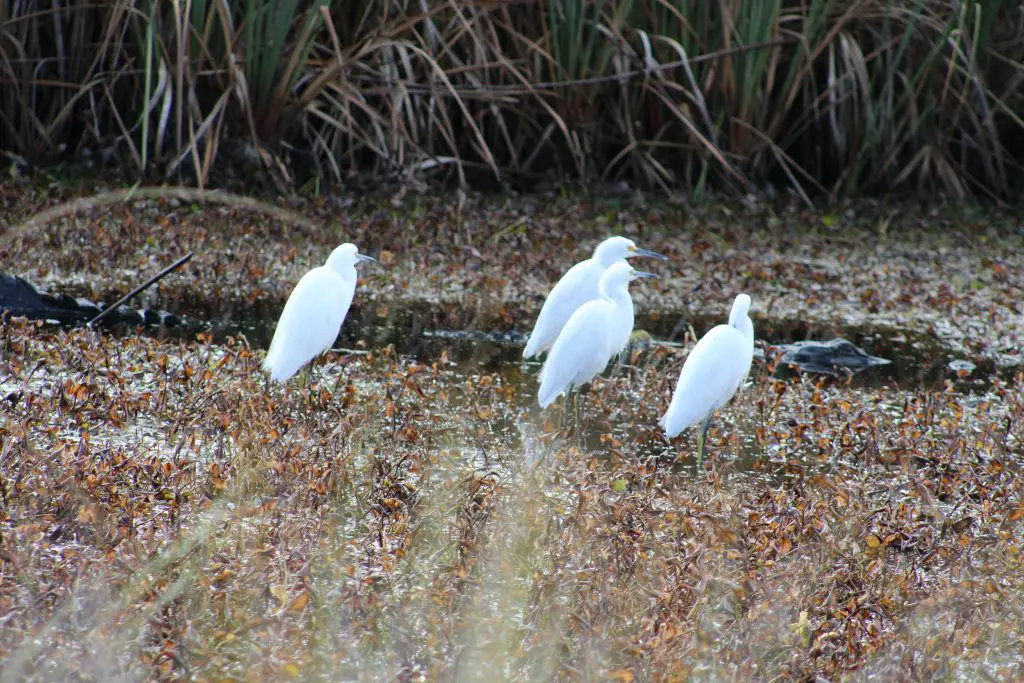
Alligator mississippiensis, commonly known as the American alligator, is an iconic reptile that thrives in the freshwater habitats of the southeastern United States. These robust creatures boast a dark, armored exterior with a distinctive U-shaped snout, setting them apart from their crocodilian relatives. Adult males can reach lengths of up to 13 feet or more, making them formidable inhabitants of marshes, swamps, and rivers.
As a Floridian, I can hardly go for a walk without seeing one of these dinosaur-like critters. If you are walking near water in Florida, you have a good chance of seeing one for yourself.
Conservation efforts have played a significant role in the rebound of the American alligator population. Once listed as endangered, their status has improved, and they are now classified as a species of “Least Concern” by the International Union for Conservation of Nature (IUCN). This success story highlights the importance of conservation initiatives in preserving the rich biodiversity of America’s wetlands and underscores the resilience of these fascinating reptiles.
American Bison
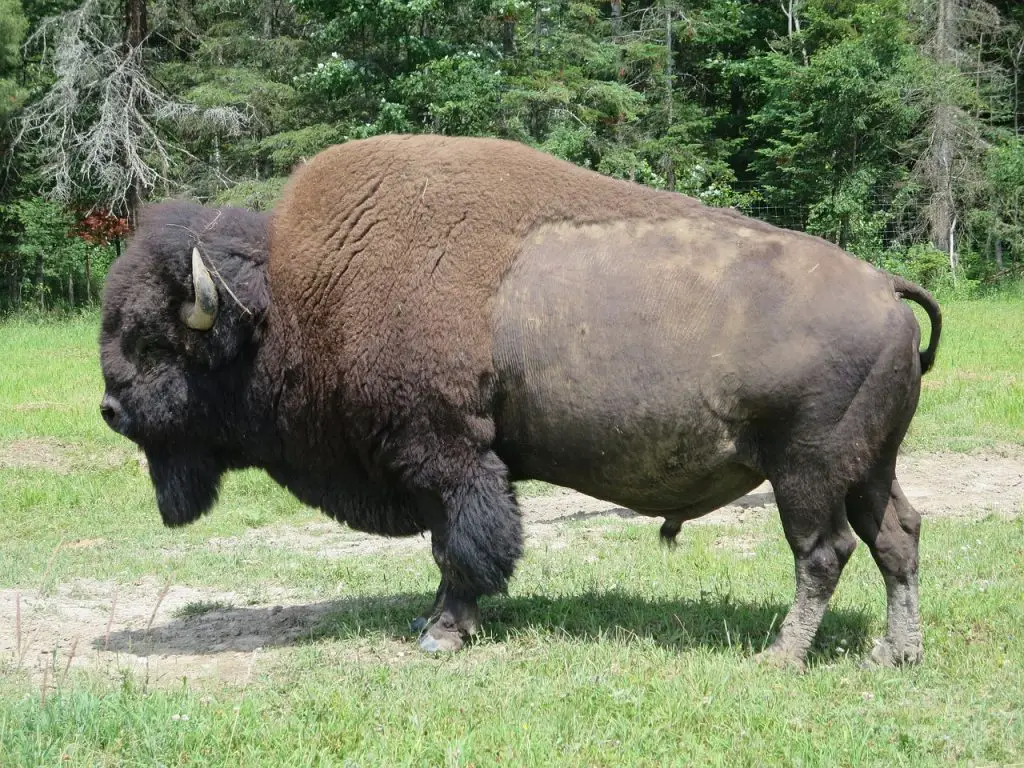
The American bison (Bison bison) stands as an iconic symbol of North America’s vast grasslands. These magnificent herbivores boast a robust build with a distinctive hump on their shoulders and a shaggy coat ranging from dark brown to nearly black. Adult males, or bulls, can weigh up to 2,000 pounds, making them one of the largest land mammals on the continent.
These resilient creatures once roamed the plains in colossal herds that numbered in the millions, serving as a vital resource for indigenous peoples. Despite facing near-extinction due to overhunting and habitat loss in the 19th century, conservation efforts have allowed their populations to rebound. Today, American bison are classified as “Near Threatened” by the International Union for Conservation of Nature (IUCN), highlighting the continued need for conservation measures to ensure their long-term survival.
When you come across a herd of bison, you can’t help but feel the connection to the past. But make sure to keep your distance!
Elk
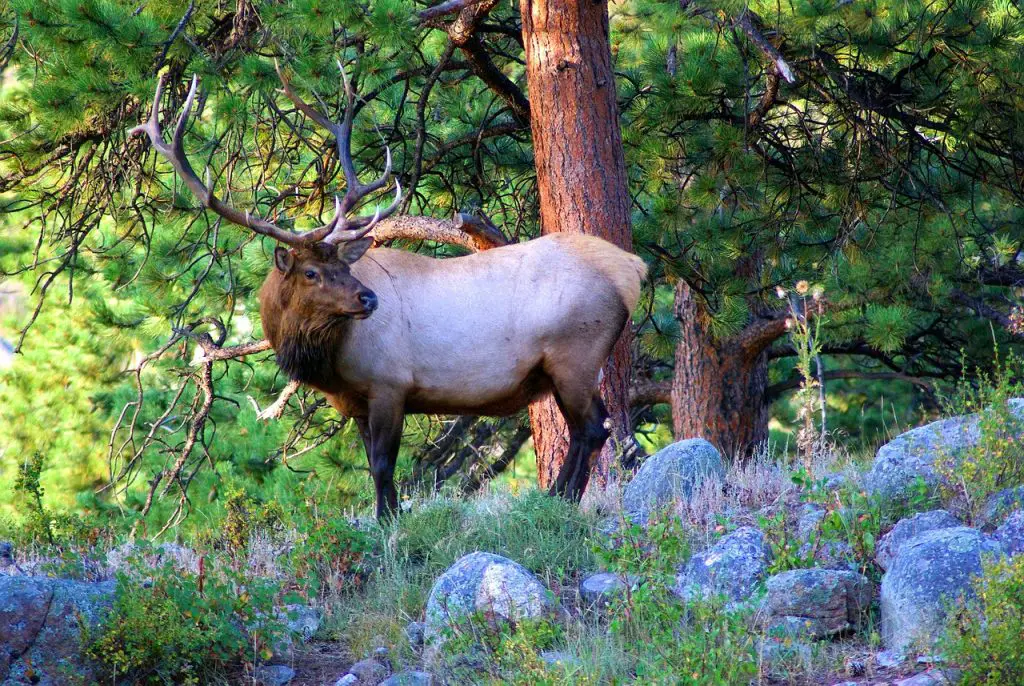
If you are lucky enough to hear the calls of an elk, the intense sound might give you chills.
Male elks, or bulls, are particularly notable for their impressive antlers, which can span up to four feet in width. The females, or cows, are distinguished by their more petite size and lack of antlers. Elk exhibit a reddish-brown coat, dark necks, and a pale rump, adding to their distinctive appearance.
In rutting season, the bulls engage in intense vocalizations and impressive displays of antler strength to establish dominance and compete for mates. This annual spectacle draws wildlife enthusiasts and photographers alike to witness the power and grandeur of these rituals. Elk are also known for their migratory patterns, covering vast distances in search of seasonal forage and suitable habitats.
Moose
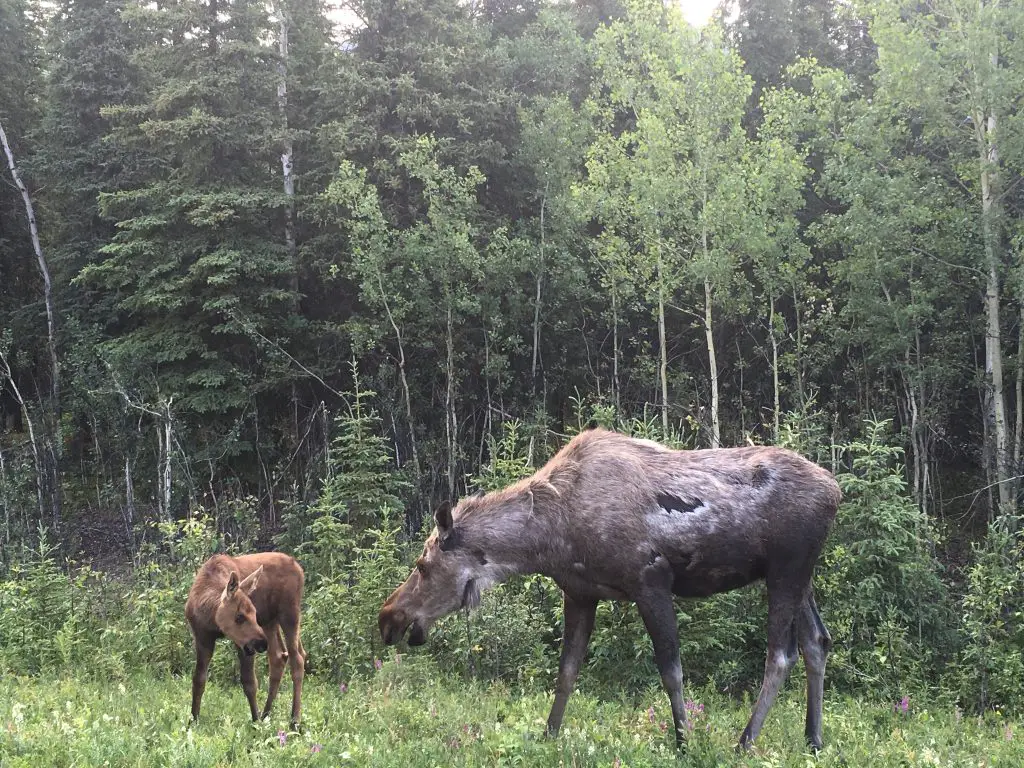
Recognizable by their towering stature and distinctive palmate antlers, moose are the largest members of the deer family. Adult males, or bulls, can weigh up to 1,500 pounds and sport antlers that can span over six feet, making them a striking presence in their natural habitats.
Moose are excellent swimmers, often navigating bodies of water with ease, and their long legs and specialized snouts make them well-adapted to foraging in aquatic environments. The first time I saw a moose, it was in a lake in Alaska. I was surprised to watch them feed there for several hours — but apparently, their preference for water isn’t uncommon.
Black Bear
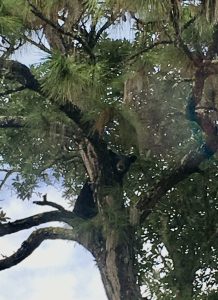
Black bears are adaptable species that roam the diverse landscapes of North America. Prior to widespread human development, these bears roamed from Florida to Alaska and everywhere in between. Today, they aren’t found in large parts of their original range.
Despite their name, black bears can exhibit a range of colors, including brown, cinnamon, and even a rare white variant known as the Kermode bear. With a robust build and sharp claws, black bears are well-equipped for climbing trees, an ability that sets them apart from their larger grizzly counterparts.
These bears are known for their resourcefulness in finding food, and their omnivorous diet includes berries, nuts, insects, and occasionally small mammals. Black bears are also proficient scavengers and can adapt to various habitats, from dense forests to open meadows.
Grizzly Bear
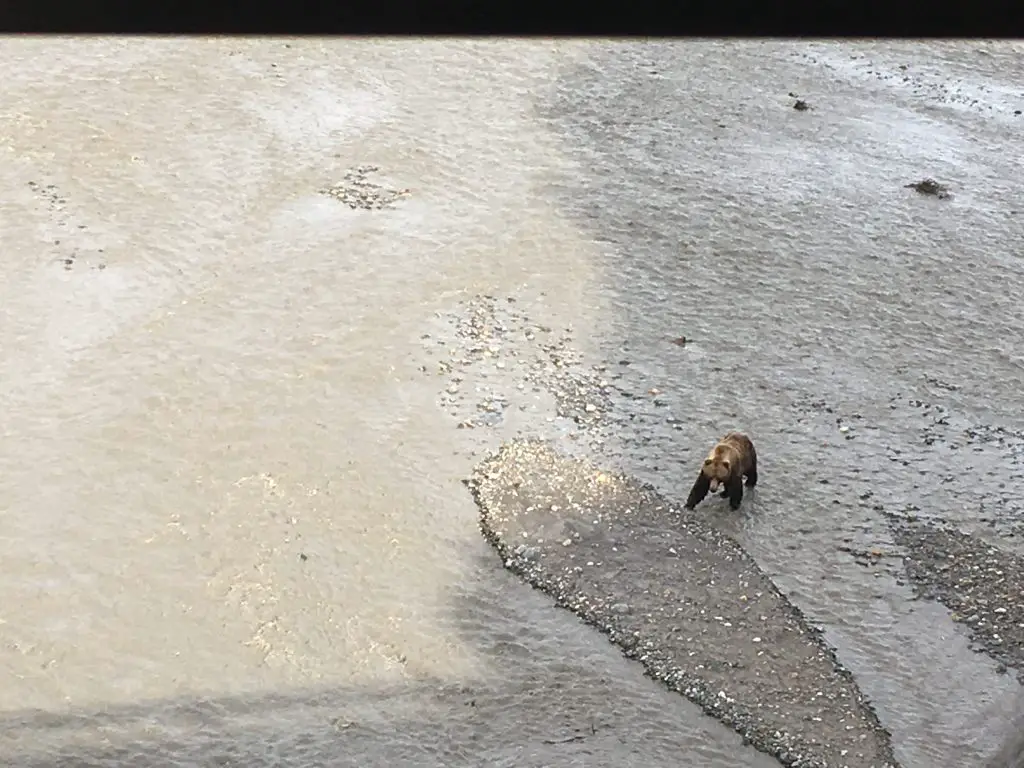
Ursus arctos horribilis, commonly known as the grizzly bear, commands a formidable presence in the wild landscapes of North America. Distinguished by their humped shoulders and powerful build, grizzlies are larger and more robust than their black bear counterparts. Their fur can range from blond to dark brown, and the distinctive hump results from powerful muscles supporting their front legs, facilitating their digging and foraging habits.
Grizzlies are iconic symbols of the wild, and their distinct presence has deep cultural and ecological significance. Their omnivorous appetite includes grasses, roots, berries, and the occasional small mammal, but they are also known for their prowess in catching fish during salmon runs.
I saw my first grizzly bear in Alaska, in Denali National Park. In the same day, I saw about a dozen more! It’s definitely a good place to go if you want to see a grizzly bear (hopefully from afar!)
Orca

The killer whale, or orca, is a marine mammal that inhabits the coastal waters of North America. With their distinctive black and white coloration, orcas are easily recognizable, featuring a sleek, torpedo-shaped body and a prominent dorsal fin. These intelligent and social creatures are known for their complex communication, using a variety of vocalizations and echolocation to navigate their underwater world and coordinate group activities.
The complex social structures within orca pods are characterized by strong familial bonds, and different pods exhibit unique cultural practices, including specialized hunting techniques and vocal dialects. Also, different groups of orcas tend to eat different things, based on what’s available and what their ancestors learned how to hunt.
(again) I saw my first orca in Alaska. The summer before, my sister and I went kayaking in search of orcas from Friday Harbor, WA but didn’t have any luck. In Alaska, we saw around 30 orcas in a single day!
American Flamingo
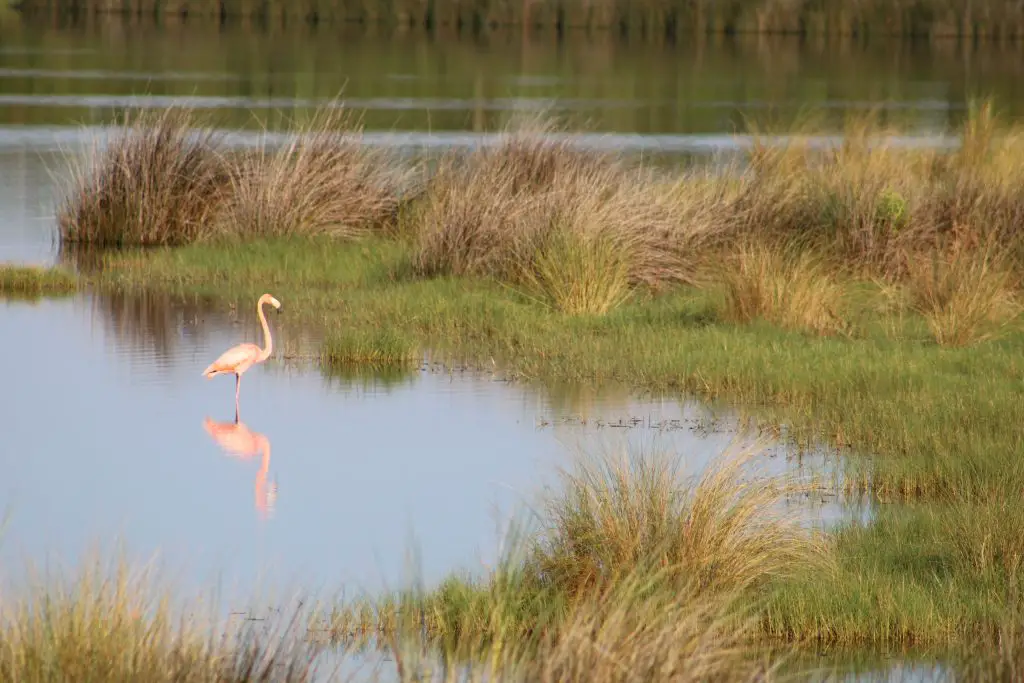
American flamingos grace the coastal habitats of North America with their distinctive elegance. These striking birds are renowned for their vibrant pink plumage, long slender necks, and distinctive downward-curving bills. The pink coloration is a result of their diet, rich in carotenoid pigments found in the crustaceans and algae they consume.
In general, these birds gather in large colonies. But it’s possible to see a loner now and then. For example, one beloved flamingo (PINKY!) was a resident star at St. Marks Wildlife Refuge in north Florida. Eventually, other flamingoes found him and went south together.
Atlantic Horseshoe Crab
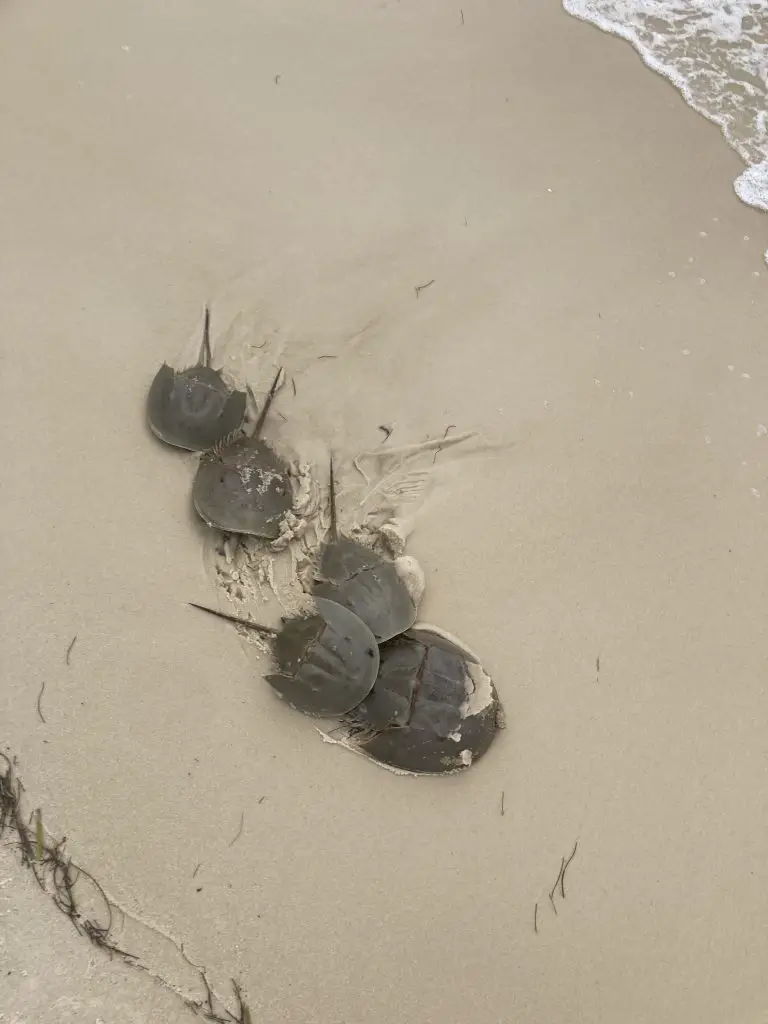
Limulus polyphemus, commonly known as the horseshoe crab, is a fascinating marine arthropod found along the Atlantic coast of North America. Despite their name, horseshoe crabs are not true crabs but belong to a unique lineage that has existed for hundreds of millions of years. These ancient creatures boast a distinctive horseshoe-shaped carapace, a long tail spine, and ten legs, underscoring their prehistoric lineage and remarkable adaptations.
Every spring, these creatures undertake a remarkable journey to coastal areas for spawning, where thousands gather to lay their eggs. The eggs serve as a vital food source for migratory shorebirds, highlighting the interconnectedness of species in coastal ecosystems. Additionally, horseshoe crab blood contains a substance called Limulus amebocyte lysate (LAL), which is crucial in the detection of bacterial endotoxins and has become invaluable in the biomedical field for testing the safety of medical equipment and vaccines.
Sandhill Crane
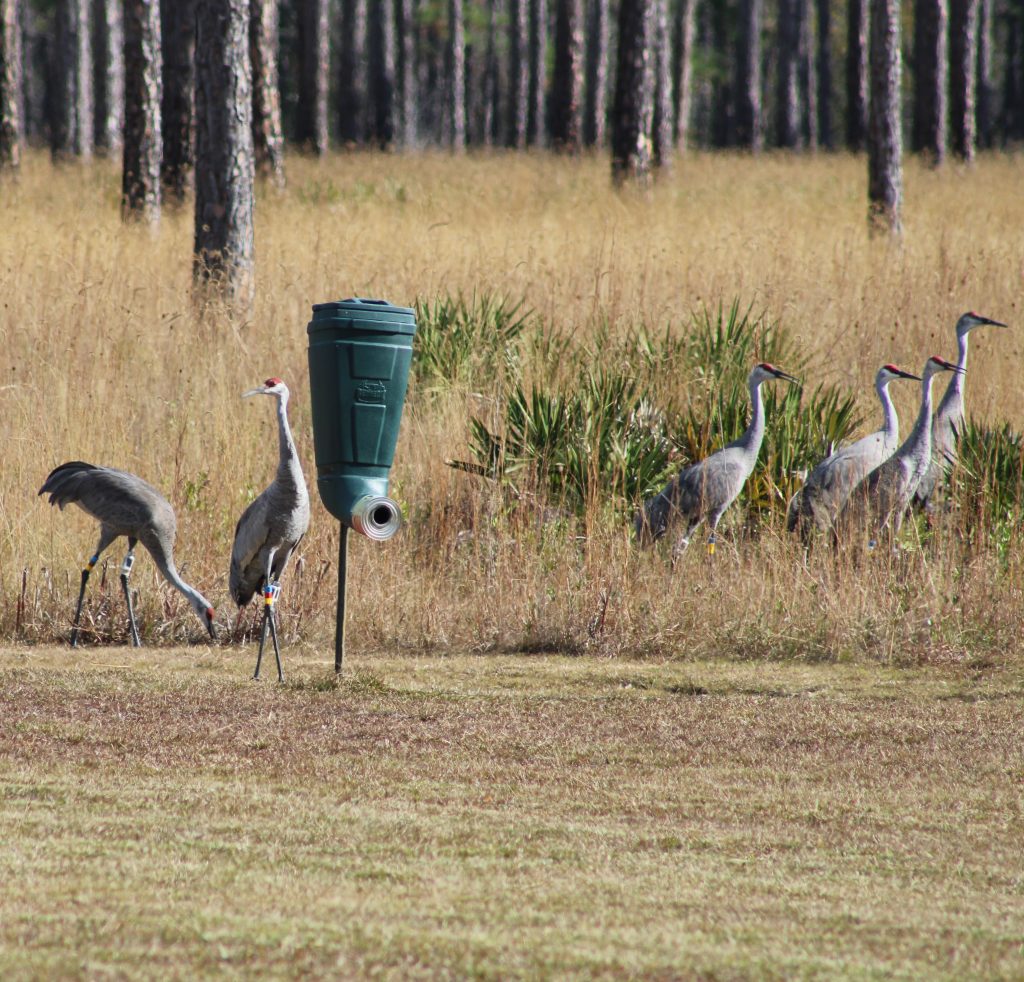
Sandhill cranes are large birds with long necks, grayish plumage, and striking red foreheads, which become more prominent during the breeding season. The birds exhibit a wingspan of up to seven feet, making them an impressive sight as they soar through the air during their long migratory journeys.
Migratory champions, sandhill cranes embark on long journeys, often covering thousands of miles between their breeding grounds in the north and wintering areas in the southern United States. Sandhill cranes also display elaborate dancing rituals, involving intricate movements and leaps, further strengthening social bonds and pair connections.
Great Blue Heron

Great blue herons are wading birds that lives in the waterways and wetlands of North America. With a wingspan that can reach up to seven feet, these birds exhibit a distinctive silhouette, characterized by long legs, a sinuous neck, and a sharp, dagger-like bill. Great blue herons boast a striking blue-gray plumage, which becomes more vibrant during their breeding season, accompanied by a plume of feathers atop their heads.
Great blue herons possess a patient and calculated hunting technique. These skilled predators stand motionless in shallow waters, patiently waiting for prey to come within striking distance. With lightning-fast reflexes, they extend their necks and use their sharp bills to capture a variety of aquatic creatures, including fish, frogs, and even small mammals. Their adaptability to diverse habitats, from coastal shorelines to inland wetlands, showcases their ecological versatility.
River Otter

The North American river otter is an agile mammal inhabiting America’s waterways. With a sleek, streamlined body, webbed feet, and a long, muscular tail, river otters thrive in their semi-aquatic lifestyle. Their dense fur, ranging from dark brown to reddish-brown, provides insulation and buoyancy, allowing them to navigate rivers, lakes, and coastal areas with ease.
River otters are voracious eaters, with a diet comprising fish, amphibians, crustaceans, and even small mammals, showcasing their adaptability to various aquatic ecosystems. These social creatures are known for their close-knit family groups, and their vocalizations, including whistles and chirps, contribute to their communication.
Monarch Butterfly

The monarch butterfly is an iconic insect that undertakes one of the most remarkable migrations in the animal kingdom. Recognized for its striking orange and black wings adorned with intricate patterns, the monarch is a symbol of beauty and fragility. Their wingspan can reach up to four inches, showcasing the delicate yet resilient nature of these butterflies.
Each year, millions of monarchs embark on a migratory odyssey, traveling thousands of miles between their breeding grounds in North America and their overwintering sites in central Mexico. This awe-inspiring migration involves multiple generations of butterflies, with each successive generation continuing the journey, guided by a combination of instinct and celestial cues. The monarch’s life cycle is intimately tied to milkweed plants, which serve as the sole host plants for their larvae. The caterpillars feed on milkweed leaves, assimilating toxins that make them unpalatable to predators, providing a vital defense mechanism.
Mule Deer

Mule deer (Odocoileus hemionus) are one of the many animals that live in America. Distinguished by their large, mule-like ears, these deer exhibit a robust build with a reddish-brown coat and a distinctive white rump patch.
Mule deer thrive in various habitats, ranging from mountainous terrains to arid deserts. Their diverse diet includes grasses, shrubs, and forbs, showcasing their adaptability to different ecosystems. Mule deer are also known for their agile and graceful movements, capable of navigating challenging terrains with ease.
Bobcat

Bobcats are stealthy wildcats with short bobbed tails, tufted ears, and distinctive spotted or mottled fur. With a compact and muscular build, they are agile hunters capable of navigating a variety of landscapes, from forests and deserts to urban areas.
These nocturnal predators are highly skilled at avoiding detection, relying on their keen senses of sight and hearing to locate prey. Bobcats are opportunistic feeders, with a diet that includes small mammals, birds, and sometimes larger prey like deer. Their adaptability to diverse environments has enabled them to coexist with humans, occasionally venturing into suburban areas in search of food.
White Ibis

White ibis are wading birds found in the wetlands and coastal areas of the Americas. With its striking all-white plumage, long curved bill, and distinctive black wingtips, the white ibis is easily recognizable. During the breeding season, adult white ibises display a vibrant reddish-pink coloration on their bills and faces, adding to their captivating appearance.
The birds feed by probing their long bills into the mud or shallow waters to locate prey such as small crustaceans, insects, and fish.
Bald Eagle

No list of animals that live in America would be complete without the bald eagle.
Bald eagles are an undeniably iconic symbol of America’s majestic wildlife. Recognized by its distinctive white head and tail contrasting with a dark brown body, the bald eagle is a symbol of strength and freedom. With a wingspan that can exceed seven feet, these raptors are formidable aerial hunters and skilled fishers, showcasing their adaptability to various aquatic habitats.
We are lucky that bald eagles are still around, since they were on the brink of extinction a few decades ago. bald eagle’s remarkable recovery from the brink of extinction. Once endangered due to habitat loss, hunting, and the impact of pesticides, conservation efforts led to their remarkable resurgence. The banning of the pesticide DDT and the implementation of protective measures such as the Bald and Golden Eagle Protection Act played pivotal roles in their recovery. Bald eagles are now considered a conservation success story, with their populations rebounding, and they have been removed from the endangered species list.
Armadillo

The armadillo is a distinctive mammal native to the Americas. Its armor-like shell is composed of nine movable bands; this small creature has a pointed snout and sharp claws, which it uses for digging and foraging. Despite its somewhat prehistoric appearance, the nine-banded armadillo is a relatively recent arrival in the United States, having expanded its range from Central and South America.
Armadillo have a quirk, which involves leaping straight into the air when startled. This defensive mechanism aims to startle potential predators and, unfortunately, often results in the armadillo colliding with the undercarriages of vehicles, making them more susceptible to road accidents.
Wild horses

Wild horses are free-roaming descendants of domestic horses that have established populations in various regions of North America. These creatures exhibit a diverse range of colors and markings, with sturdy builds and flowing manes that contribute to their iconic appearance. Their resilience and adaptability allow them to thrive in a variety of landscapes, from arid deserts to lush grasslands.
Horses exhibit a complex social structure. These social groups, known as bands, are typically led by a dominant stallion responsible for protecting the group and maintaining order. These wild ones also display fascinating behaviors such as mutual grooming, playful interactions, and coordinated movements. Despite their untamed existence, they have become integral components of the ecosystems they inhabit, contributing to biodiversity and serving as symbols of freedom and the untamed spirit of the American West.
Freshwater Mussels

Freshwater mussels are the unsung heroes of America’s wild rivers. As filter feeders, a healthy freshwater mussel population can help keep a river healthy. The Southeastern U.S. boasts of one of the most biodiverse collection of freshwater mussel species in the world.
These mollusks have unique shell shapes and intricate patterns, ranging from elongated and smooth to more rounded with distinct ridges. Their ability to filter water makes them essential for maintaining water quality, as they effectively remove particles and contribute to nutrient cycling.
The seemingly simple creatures have a complex life cycle. Their larvae, called glochidia, attach themselves to fish gills for a short period, utilizing the fish as hosts before dropping off to settle on the riverbed. This dependency on specific fish species for part of their life cycle highlights the intricate relationships between mussels and their aquatic habitats.
Humpback Whales

The humpback whale is a marine mammal with long pectoral fins and a pronounced hump on their backs, which becomes more apparent when they arch their backs before diving. Their robust bodies can reach lengths of up to 60 feet, making them one of the larger species of baleen whales.
These whales undertake long journeys, covering thousands of miles between their feeding grounds in cold, nutrient-rich waters and their breeding and calving areas in warmer tropical or subtropical regions. Their acrobatic displays, including breaching, tail slapping, and flipper waving, add to the awe-inspiring spectacle of these marine giants. Humpback whales are also known for their haunting and complex songs, which can last for hours and serve as a form of communication, potentially linked to mating rituals.
Animals That Live In America: Frequently Asked Questions
You have questions about the animals that live in America. We have answers.
What is an iconic USA animal?
Bald eagles are an iconic animal in the U.S. Others include bison, alligators, elk, moose, and more.